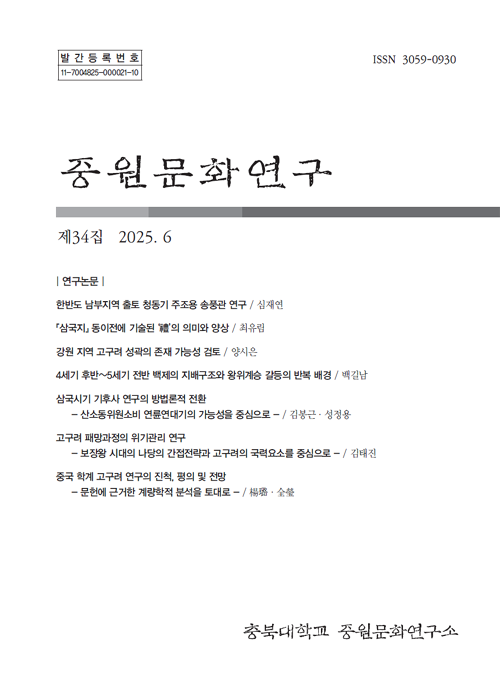- 영문명
- Baekje's Governance and Royal Succession Conflicts in the Late 4th to Early 5th Centuries
- 발행기관
- 충북대학교 중원문화연구소
- 저자명
- 백길남(Kil-nam Baek)
- 간행물 정보
- 『중원문화연구』제34집, 61~85쪽, 전체 25쪽
- 주제분류
- 인문학 > 역사학
- 파일형태
- 발행일자
- 2025.06.30
5,800원
구매일시로부터 72시간 이내에 다운로드 가능합니다.
이 학술논문 정보는 (주)교보문고와 각 발행기관 사이에 저작물 이용 계약이 체결된 것으로, 교보문고를 통해 제공되고 있습니다.

국문 초록
4세기 후반에서 5세기 전반 백제 국왕은 扶餘氏 肖古系가 왕위를 잇는다는 점은 확고해졌으나 扶餘氏 肖古系 중 특정 가계가 왕위를 독점하지는 못하였다. 그리하여‘적장자’계승 원칙에도 불구하고 정치적 상황에 따라 유력한 왕제인‘적임자’가 왕위를 잇는 변칙이 허용되었다. 왕제 등 근친 왕족이 가진 정치적 위상, 경제적 특권, 私的 군사력을 무시할 수 없었기 때문이다.
眞氏와 解氏는 군사적 기반을 바탕으로 부여씨 왕실과 꾸준히 통혼하며 주요 직임을 맡았고, 특히 兵官佐平으로 상징되는 군사권을 독점했다. 이들은 차기 왕위계승자를 지지하며 왕실과의 인척 관계를 안정적으로 유지하려 했으며, 왕실과 통혼이 이루어지지 못하는 경우 주요 직임에서 배제되는 정치적 한계가 있었다.
上佐平, 內臣佐平, 병관좌평과 같은 핵심 직임은 왕족과 외척 세력이 관례적으로‘분담’하였다. 이는 곧 국왕의 자율적인 인사권과 군사권 행사의‘제약’을 의미하는 것이었고 왕권이 친족집단의 이해관계에서‘초월’할 수 없었음을 반증한다. 그럼에도 불구하고 이러한 지배구조가 고수된 것은 방계 왕족의 왕위 도전을 제어하기 어려웠던 상황이었기에 가까운 친족집단을 왕실의 울타리로 삼는 게 급선무였기 때문이었다. 또한 부여씨, 진씨, 해씨의 공동 이익을 지키는 것이기도 하였다. 沙氏, 木氏 등 새로운 유력 성씨 집단과 中國系 유력 인사들이 성장하는 가운데,‘백제 최대 귀족 세력’인 부여씨는 왕위계승과 국정 운영의 안정을 위해 진씨, 해씨와 선택적으로 연합하며 통혼했으며 진씨, 해씨 또한 왕실과 인척 관계를 통해 기득권을 유지하고자 하였다.
친족집단마다 가진 이해관계와 핵심 권력을‘분담’하는 관례에 따라 부여씨 특정 가계가 왕위를‘독점’할 수 없는 지배구조가 형성되었다. 정치적 상황에 따라 왕위계승 갈등이‘반복’되기는 했지만, 부여씨, 진씨, 해씨 세력은 주요 직임과 핵심 권한을 독점하는 지배구조를 굳건히 유지할 수 있었다.
영문 초록
The distribution of key administrative and military positions, such as Sang-jwapyeong, Naesin-jwapyeong, and Byeonggwan-jwapyeong, among the royal family and powerful in-laws inherently constrained the king's authority over appointments and military control. This arrangement undeniably indicates that the monarch could not truly transcend the vested interests of their kin group. Nevertheless, this power-sharing governance structure persisted. This was primarily because, in a situation where challenges to the throne from collateral branches of the royal family could not be easily controlled, it became crucial to fortify the royal house by integrating close relatives.
Moreover, this system served the common interests of the Buyeo, Jin, and Hae clans. It was difficult to disregard a political landscape where other influential aristocratic clans, such as the rising Sa and Mok clans, and even Chinese immigrants, coexisted. As the foremost aristocratic power in Baekje, the Buyeo clan strategically allied and intermarried with the second-tier Jin and Hae clans to ensure stable royal succession and effective state administration. Similarly, the Jin and Hae clans sought to secure their established privileges by maintaining their marital ties with the royal family.
Thus, while the Baekje governance structure, shaped by the interests of these kin groups, prevented any single Buyeo lineage from monopolizing the throne and led to recurrent succession conflicts, it simultaneously enabled the Buyeo, Jin, and Hae clans to maintain a robust political cartel, effectively monopolizing key offices and core authorities.
목차
Ⅰ. 머리말
Ⅱ. 王弟의 왕위계승 자격과 왕위 도전
Ⅲ. 外戚勢力의 주요 직임 독점
Ⅳ. 유력 성씨 집단의 竝存
Ⅴ. 맺음말
참고문헌
키워드
해당간행물 수록 논문
참고문헌
관련논문
인문학 > 역사학분야 NEW
- China Energy Transition in Past Four Decades: Achievement and Limitation
- Study on the Response to the Independent Assurance of the EU Corporate Sustainability Reporting Directive
- The Practical View of “Oppose Book Worship” and Its Enlightenment to Ideological and Political Work
최근 이용한 논문
교보eBook 첫 방문을 환영 합니다!

신규가입 혜택 지급이 완료 되었습니다.
바로 사용 가능한 교보e캐시 1,000원 (유효기간 7일)
지금 바로 교보eBook의 다양한 콘텐츠를 이용해 보세요!



